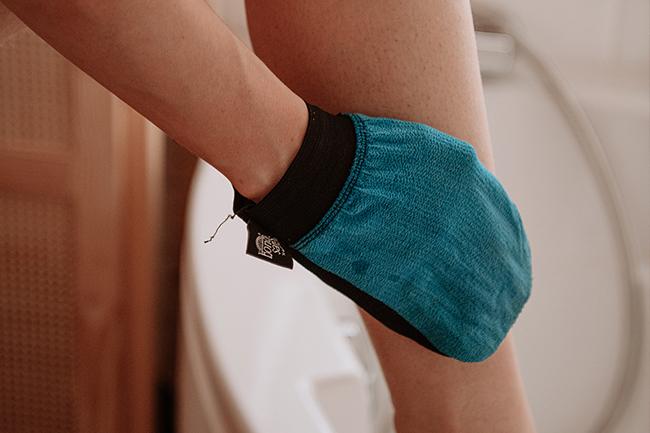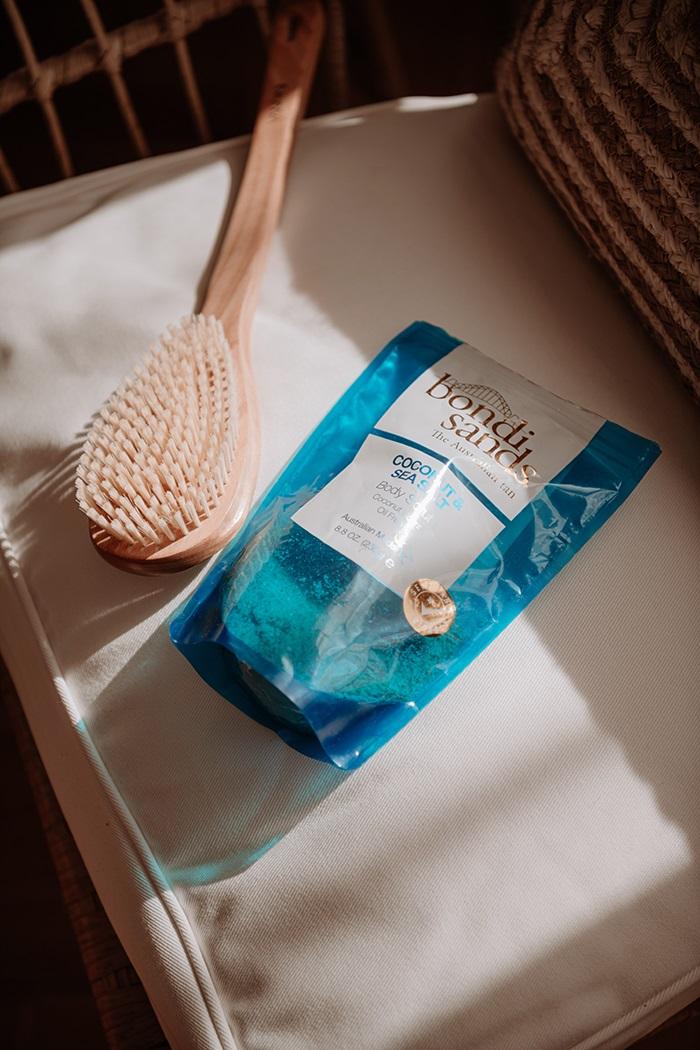There are so many different treatments and processes out there to achieve the skin and body of your dreams, but how do they all work together? We all know that exfoliation is great for replenishing your skin and revealing a glowier face and body, but it’s not always good for your tan.
If you want to find out more about how exfoliating can affect your tan, read on to find out.
Does exfoliating remove a suntan?

Of course, there are different types of tan – both natural and artificial – and they both work and react differently to different processes. As we jump into whether or not exfoliating removes your tan, we’ll start by looking at a natural suntan.
Firstly, it’s worth understanding how a natural suntan occurs, as this will be beneficial for understanding whether it’s removed by the process of exfoliation.
When you spend time in the Sun, you’re exposed to the Sun’s UV rays, and one type of these rays, UVA, penetrates into the deeper layers of your skin and reaches melanocytes. These are small structures beneath the epidermis of the skin which produce melanin, the pigment which determines our skin tone, as well as eye colour and hair colour.
When the UVA rays reach the melanocytes, they trigger the production of melanin which becomes present in the cells and darkens the skin.
| Exfoliation Method | Effectiveness |
|---|---|
| Physical Exfoliation | Can help to slough off dead skin cells and partially remove superficial tan |
| Chemical Exfoliation | More effective in breaking down and fading tan from deeper layers of the skin |
| Combination Exfoliation | Offers a comprehensive approach to tan removal, targeting both superficial and deep layers of the skin |
When it comes to exfoliation, this process speeds up the natural cycle of cell turnover in the skin, which is the natural process responsible for the fade of your suntan in the first place. Once the tanned cells in your skin are gradually replaced, the tan fades.
Exfoliation removes these dead cells faster, so the answer is yes, gentle exfoliation can remove your suntan to a certain degree, but it’s also worth noting that it can be good for maintaining a good suntan throughout the summer months, too. If you’re receiving regular exposure to the sunlight, regular exfoliation won’t make a huge difference to your skin tone, as the cells beneath have already been tanned, too.
- EXFOLIATING & MOISTURIZING FACIAL & BODY SCRUB: Our Brown Sugar Body Scrub and Face Scrub is a gentle sugar scrub that can be used as a Facial Scrub, Body Scrub, and Foot Scrub. It is a triple action body and face exfoliator and moisturizer. Containing only pure and natural ingredients, it acts as a natural exfoliator removing dead skin, and moisturizing to reveal fresher healthier clear skin.
- GREAT FOR SENSITIVE SKIN: While salt scrubs may be too harsh for sensitive skin, this Brown Sugar Scrub is a great facial scrub exfoliator and for sensitive skin. It is softer than regular sugar scrubs, while remaining strong enough to scrub away dead skin cells and make way for the healthier, glowing clear skin. Use our Brown Sugar Facial Scrub, Body Scrub, and Foot Scrub for moisturized smooth skin.
If you click Buy on Amazon and make a purchase, I'll earn a small commission at no additional cost to you.
Also read: Does Exfoliating Help Dry Skin? (Explained)
Does exfoliating remove a spray tan?
Next up, it’s time to take a look at spray tans, and whether an exfoliation session will affect them.
Unlike a suntan, spray tans work from the surface of the skin, usually utilising the powers of an ingredient known as DHA, to pigment the skin. This DHA tints the outermost layers of the epidermis (outer layer of the skin), and therefore a spray tan doesn’t work as deeply as a suntan does.
Because of this, exfoliation can remove a spray tan more easily than a suntan, and enough exfoliation can remove a spray tan completely. Often, exfoliation is used to remove excess build-up of old spray tan product before applying more and removes any leftover colour when the tan has faded.
Also read: When And How to Exfoliate Before a Spray Tan? (Explained)
Does exfoliating remove self-tanner?
While spray tans and self-tanner are applied using slightly different processes, they often have very similar properties to each other, as they both tend to use DHA as the active tanning ingredient.
Because the active ingredient is both is DHA, they both work in a very similar way, with the DHA tinting the outermost layer of the skin, and this makes a spray tan very similar to self-tanner. Therefore, they generally both react in the same way to exfoliation, and this means that exfoliation can also remove self-tanner, too.
While this can be a useful thing, such as when your self-tanner develops wrong or the product begins to fade unevenly, it can also be limiting, as you can’t exfoliate if you’re hoping to keep your sun-kissed glow.
- SELF TANNER: Our most iconic & foolproof self tan - lightweight & quick-drying formula for a beautiful streak-free natural-looking tan
- BEAUTY PRODUCTS: This trusted fake tan develops into a natural golden glow that lasts up to 10 day wear
If you click Buy on Amazon and make a purchase, I'll earn a small commission at no additional cost to you.
Should I exfoliate before or after tanning?

As mentioned, the ability to remove a spray tan or self-tanner can be used to your advantage, but it can also be frustrating and difficult when you’re trying to keep your tan. So, is it best to exfoliate before or after tanning?
When it comes to both spray tans and self-tanner, the best time to exfoliate is around 12-24 hours before tanning, as this removes any build-up of dead skin cells, as well as leftover product from a previous tan, and smooths any texture. At the same time, it also allows your skin to recover a little before the tan is applied, leaving the perfect conditions for a flawless tan.
| Tip | Description |
|---|---|
| Start Gradually | Begin with gentle exfoliation methods and gradually increase intensity as tolerated |
| Moisturize | Follow up exfoliation with a nourishing moisturizer to keep the skin hydrated and supple |
| Patience is Key | Tan removal through exfoliation is a gradual process that requires consistency and patience |
| Sun Protection | Always use sunscreen, especially after exfoliation, to protect the skin from harmful UV rays |
If you choose to exfoliate straight after having a fresh spray tan or applying self-tanner, you’ll likely cause an uneven tan as you begin to strip some of the product off, and the tan will fade much faster. Instead, it’s best to wait until the tan has faded itself, and exfoliate when the fade becomes uneven, or just in time for your next application.
In terms of a suntan, as mentioned earlier, exfoliation can remove the tan to a certain extent, but the case is different when you’re constantly exposed to the sun, such as in the summer, as melanin is being produced constantly. Instead, exfoliation can occur at any point, as it’s good for maintaining a healthy glow and preventing your skin peeling due to your suntan.
Just ensure that you’re moisturising your skin, to keep up with appropriate skin hydration levels.
Also read: Does Self-Tanner Remover Work? (Is It Worth Buying?)
Final thoughts
In short, the answer is yes, exfoliation can remove any kind of tan, as it speeds up the process of cell turnover and therefore removes the pigmented cells much faster. However, it affects a spray tan or self-tanner the most, and therefore shouldn’t be carried out after a fresh tan application.



